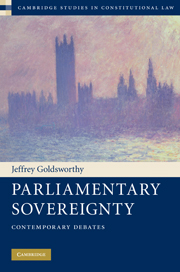Book contents
- Frontmatter
- Contents
- Detailed table of contents
- Acknowledgments
- 1 Introduction
- 2 The myth of the common law constitution
- 3 Legislative sovereignty and the rule of law
- 4 Homogenising constitutions
- 5 Abdicating and limiting Parliament's sovereignty
- 6 Trethowan's case
- 7 Requirements as to procedure or form for legislating
- 8 Judicial review, legislative override, and democracy
- 9 Parliamentary sovereignty and statutory interpretation
- 10 Challenging parliamentary sovereignty: Past, present and future
- Index
- References
7 - Requirements as to procedure or form for legislating
Published online by Cambridge University Press: 05 October 2010
- Frontmatter
- Contents
- Detailed table of contents
- Acknowledgments
- 1 Introduction
- 2 The myth of the common law constitution
- 3 Legislative sovereignty and the rule of law
- 4 Homogenising constitutions
- 5 Abdicating and limiting Parliament's sovereignty
- 6 Trethowan's case
- 7 Requirements as to procedure or form for legislating
- 8 Judicial review, legislative override, and democracy
- 9 Parliamentary sovereignty and statutory interpretation
- 10 Challenging parliamentary sovereignty: Past, present and future
- Index
- References
Summary
Introduction
One of the most important questions not settled by the doctrine of parliamentary sovereignty is whether, and how, Parliament can make the legal validity of future legislation depend on compliance with statutory requirements as to procedure or form. A requirement as to procedure is a requirement that Parliament follow a particular procedure in order to enact legislation of a certain kind. A requirement as to form is a requirement that such legislation take or include some particular form (for example, a particular form of words). Such requirements might be designed to protect important legislation from inadvertent or ill-considered amendment or repeal, by prompting more careful or extensive deliberation within Parliament than is required to enact ordinary legislation. They might also serve other purposes, such as: (a) to ensure that a bill likely to be controversial is brought to public attention; (b) in the case of requirements as to form, to ensure that Parliament expresses its intentions with unmistakable clarity in order to avoid subsequent misunderstandings; or (c) to differentiate between the respective functions of the two Houses in a bicameral system.
In this chapter I will argue that legally binding and judicially enforceable requirements as to procedure or form are consistent with parliamentary sovereignty, provided that they do not control or restrict the substantive content of legislation, or make it so difficult for Parliament to legislate that its power to do so is diminished. The second qualification, admittedly, gives rise to questions of degree.
- Type
- Chapter
- Information
- Parliamentary SovereigntyContemporary Debates, pp. 174 - 201Publisher: Cambridge University PressPrint publication year: 2010



